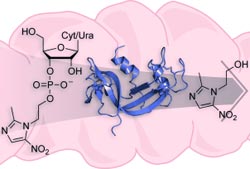Timely Delivery

<br>
Many drug candidates fail because of low solubility or poor pharmacokinetic behavior. Ron Raines and colleagues at the University of Wisconsin–Madison (USA) have devised a new prodrug strategy to overcome these limitations.
Their approach takes advantage of the capacity of an enzyme prevalent in human serum–pancreatic-type ribonuclease—to catalyze the cleavage of a drug conjugated to a ribonucleoside 3'-phosphate; the results of their work are reported in ChemMedChem.
They demonstrated efficacy by using metronidazole, a sparingly soluble antibiotic that is often administered orally. In the absence of ribonuclease, metronidazole conjugates are stable and inactive. Physiological levels of enzyme render the conjugate toxic to Bacteroides fragilis, a common penicillin-resistant bacillus that is responsible for anaerobic infections.
Alterations to the ribonucleoside enable modulation of key attributes, such as the rate of drug delivery. This study paves the way for further research into the activation and timed release of drugs of varying aqueous solubility.
About the Author
Dr. Ronald T. Raines is the Henry Lardy Professor of Biochemistry and a Professor of Chemistry at the University of Wisconsin–Madison. His research is focused on the chemistry and biology of proteins.
Author: Ronald T. Raines, University of Wisconsin–Madison (USA), http://www.chem.wisc.edu/users/raines
Title: Ribonucleoside 3'-Phosphates as Pro-Moieties for an Orally Administered Drug
ChemMedChem 2012, 7, No. 8, Permalink to the article: http://dx.doi.org/10.1002/cmdc.201200243
Media Contact
All latest news from the category: Life Sciences and Chemistry
Articles and reports from the Life Sciences and chemistry area deal with applied and basic research into modern biology, chemistry and human medicine.
Valuable information can be found on a range of life sciences fields including bacteriology, biochemistry, bionics, bioinformatics, biophysics, biotechnology, genetics, geobotany, human biology, marine biology, microbiology, molecular biology, cellular biology, zoology, bioinorganic chemistry, microchemistry and environmental chemistry.
Newest articles

Trotting robots reveal emergence of animal gait transitions
A four-legged robot trained with machine learning by EPFL researchers has learned to avoid falls by spontaneously switching between walking, trotting, and pronking – a milestone for roboticists as well…

Innovation promises to prevent power pole-top fires
Engineers in Australia have found a new way to make power-pole insulators resistant to fire and electrical sparking, promising to prevent dangerous pole-top fires and reduce blackouts. Pole-top fires pose…

Possible alternative to antibiotics produced by bacteria
Antibacterial substance from staphylococci discovered with new mechanism of action against natural competitors. Many bacteria produce substances to gain an advantage over competitors in their highly competitive natural environment. Researchers…





















